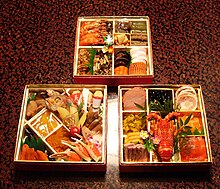Osechi-ryōri
Osechi-ryōri ( Japanese 御 節 料理 or お 節 料理 , short Osechi ) are traditional Japanese New Year dishes . The tradition began in the Heian period (794–1185). Osechi can easily be recognized by their special boxes ( jūbako ), which are reminiscent of Bentō boxes. Like Bentō boxes, the jūbako are often stacked before and after use.
Typical dishes
The dishes belonging to the osechi all have a specific meaning in relation to the New Year. Examples are:
- Daidai ( 橙 , Citrus aurantium var. Daidai ), a Japanese bitter orange . Daidai also means "from generation to generation" when written using the Kanji 代 々 . Like kazunoko below, it symbolizes the desire for children in the New Year.
- Datemaki (伊達 巻 or伊達 巻 き ), sweet, rolled-up omelette, mixed with fish paste or pureed shrimp . They symbolize the wish for many promising days. On these days (晴 れ の 日 , hare-no-hi ) the Japanese traditionally wore good clothes.
- Kamaboko (蒲 鉾 ), slices of steamed fish paste. Traditionally, disks made of red and white kamaboko are used , which are arranged alternately in rows or patterns. The color and shape are reminiscent of the symbol of the rising sun and have a festive meaning.
- Kazunoko (数 の 子 ), herring roe. Kazu means "number" and ko means "child". It symbolizes the wish for many children in the new year.
- Konbu (昆布 ), a type of seaweed, is associated with the word喜 ぶ yorokobu , which means "to be happy".
- Kuro-mame ( 黒 豆 ), black soybeans . Mame also means "health" and symbolizes the desire for health in the new year.
- Tai ( 鯛 ), the sea bream , Japanese tai , is associated with the Japanese word Medetai , which symbolizes a promising event.
- Tazukuri (田作 り ), dried sardines that arecookedin soy sauce . The literal meaning of the Kanji in tazukuri is "rice paddy maker " as fish was used to fertilize rice paddies. They symbolize a rich harvest.
history
The term osechi originally referred to o-sixi , a season or an important period of time. New Year's Day was one of the five seasonal festivals ( 節 句 Sekku ) at the imperial court in Kyōto . This custom of celebrating certain days came to Japan from China.
It used to be taboo to use a stove and cook meals during the first three days of the New Year. The exception was the cooking of Zōni soup. Since the women did not cook at the beginning of the new year, the osechi were prepared at the end of the old year. Today the osechi are cooked like normal meals in most families and the religious aspect has been lost.
In the earliest times, osechi consisted only of nimono , various cooked vegetables with soy sauce and sugar or mirin (sweet rice wine). Over time, more and more dishes were added.
Today, osechi can refer to any food specially prepared for the New Year, and some foreign dishes have also found their way into "Western osechi " ( 西洋 お 節 seiyō-osechi ) or " Chinese style osechi " ( 中華 風 お 節 chūkafū osechi ). While osechi were traditionally prepared at home, they are now also offered in specialty stores , grocery stores and convenience stores .
Especially in households where the osechi are still made at home, toshi-koshi soba ( 年 Neu し 蕎麦 ) is eaten the day before the New Year . Her name literally means “soba that crosses the year.” Although there are some symbols associated with it, such as long life, health and energy for the coming year, this tradition is probably more of a pragmatic nature: The one that is already strong with the preparation of the osechi for several days busy traditional housewife preferred to serve an easy-to-prepare meal for the day. It is considered by many Japanese to be an unfavorable sign to leave something of the toshi-koshi soba .
literature
- "Osechi ryōri" . In: Alan Campbell, David S. Noble (Eds.): Japan. An Illustrated Encyclopedia . 7. print. Kōdansha, Tokyo 1995, ISBN 4-06-205938-X .
